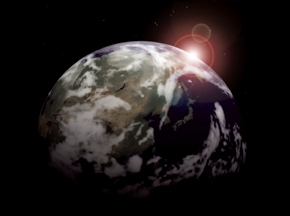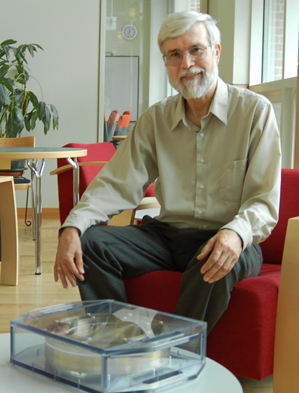Herr Distinguished Professor
LAST YEAR, the UNH Physics Department established an awards committee to bolster the department’s chances of getting people nominated for faculty, staff, and student recognition – something that had not been happening on a regular basis.
It didn’t take long for the move to pay off in an unexpected way. Eberhard Möbius, who was appointed chair of the Physics Department last year, was nominated for and selected as the 2009 UNH Distinguished Professor – the first Physics Department faculty to be so recognized in 20 years.
The long-time EOS and Physics Department faculty member talks about the honor with characteristic modesty, but those who work with Möbius say the award is richly deserved given his distinctive record of research, teaching, and service since coming to UNH from the Max Planck Institute for Extraterrestrial Physics in 1990.
In a letter of support for Möbius’ nomination, Space Science Center colleague Marty Lee noted, “Put simply, Eberhard is outstanding not only as a compassionate teacher and conscientious mentor or supervisor, but also as a world-class researcher in space physics and exemplary leader of his team of experimental researchers.”
The award comes at a time when Möbius feels his research career has come full circle – from the first space instrument he built in Germany to the current Interstellar Boundary Explorer (IBEX) mission, which launched this past October and for which he is the UNH principal investigator.
On the 1984 Active Magnetospheric Particle Tracer Explorers (AMPTE) mission, Möbius made the serendipitous discovery of “pick-up” ions that are created when atoms from the interstellar wind flow in from outside our solar system. The finding marked the first time scientists could study particles that stem from the local interstellar environment.
Some 25 years later, with IBEX, this same work is culminating with “seeing” directly the neutral gas flow of the interstellar wind. Says Möbius, “Back then we were only able to see some secondary particles in the form of the pickup ions. And, today, we have also developed the ability to produce the first full-sky map or image of the boundary between the solar system and our local galactic neighborhood.” He adds, “What we’re doing with IBEX is opening up yet another window for astronomy.”
Looking back through history, the first “window” of astronomy was the visible light seen with the naked eye. Then, in the World War II era, radio telescopes were invented to detect radio waves from outer space, which can penetrate Earth’s thick atmosphere. With the dawn of the space age several more windows opened to include the entire electromagnetic spectrum.
The neutral atoms being measured by IBEX are yet another window because they offer a view of the edge of our solar system; scientists know they have traveled in a straight line from those far distances thanks to the evermore sophisticated “time-of-flight” instruments Möbius and colleagues have built (and placed on the Cluster, FAST, and STEREO missions) over 25 years.
But stellar research alone does not a Distinguished Professor make; successful nominees must receive recognition from colleagues across campus – not just their affiliated college or department.
In that regard, Möbius’ long-time involvement in a cross-disciplinary seminar entitled “Cosmology and Our View of the World” may have helped matters.
“I’ve been doing this seminar for a long time now with colleagues from philosophy and life science and I think that might have contributed to the award,” Möbius speculates.
The seminar or “preceptorial” is open to students at all levels and majors and, through a format of open discussion, “explores the sources and limits of human knowledge concerning the origin of the universe, the origin and distribution of life in the universe, and the mystery of our consciousness,” which allows us to be aware of ourselves and the universe. No run-of-the-mill GenEd course this!
Indeed, Cosmology and Our View of the World is intended to “serve as an expression of a shared desire to delve deeply into the mysteries of our existence as conscious beings in a vast universe.”
The 90-minute class is the only one Möbius has encountered where students don’t get restless in their seats when, as it were, the bell rings. “In other classes when you run over by couple of minutes, immediately there’s this restlessness in the air. That just doesn’t happen.” To wit: this past semester the instructors finally had to pack it in an hour after class was officially over while the students stayed behind and kept the discussion going into the night. “If you can ignite a discussion like that you know your goal has been achieved,” Möbius says.
But as Marty Lee notes, Möbius’ teaching experience is deep, wide, and highly valued by students – who find both the subject matter and the man accessible.
“Eberhard has excelled as a classroom educator, from teaching the undergraduate Introduction of Modern Astronomy to an elective graduate course on heliospheric physics, his specialty, and contributing to a graduate course on Space Instrumentation and a graduate seminar,” Lee says.
As part of his undergraduate teaching, Möbius has made it a habit to take students to the McAuliffe-Shepard Discovery Center in Concord, N.H., for which he has also developed educational outreach programs about our space environment in an effort to bring the mysteries of our universe down to Earth for the average citizen. And that’s just one aspect of the public service part for which he is being recognized as the 2009 Distinguished Professor. -DS
For more on Cosmology and Our View of the World visit www.ssg.sr.unh.edu/preceptorial.
It didn’t take long for the move to pay off in an unexpected way. Eberhard Möbius, who was appointed chair of the Physics Department last year, was nominated for and selected as the 2009 UNH Distinguished Professor – the first Physics Department faculty to be so recognized in 20 years.
Eberhard Möbius
Photo by K.Donahue, UNH-EOS |
In a letter of support for Möbius’ nomination, Space Science Center colleague Marty Lee noted, “Put simply, Eberhard is outstanding not only as a compassionate teacher and conscientious mentor or supervisor, but also as a world-class researcher in space physics and exemplary leader of his team of experimental researchers.”
The award comes at a time when Möbius feels his research career has come full circle – from the first space instrument he built in Germany to the current Interstellar Boundary Explorer (IBEX) mission, which launched this past October and for which he is the UNH principal investigator.
On the 1984 Active Magnetospheric Particle Tracer Explorers (AMPTE) mission, Möbius made the serendipitous discovery of “pick-up” ions that are created when atoms from the interstellar wind flow in from outside our solar system. The finding marked the first time scientists could study particles that stem from the local interstellar environment.
Some 25 years later, with IBEX, this same work is culminating with “seeing” directly the neutral gas flow of the interstellar wind. Says Möbius, “Back then we were only able to see some secondary particles in the form of the pickup ions. And, today, we have also developed the ability to produce the first full-sky map or image of the boundary between the solar system and our local galactic neighborhood.” He adds, “What we’re doing with IBEX is opening up yet another window for astronomy.”
Looking back through history, the first “window” of astronomy was the visible light seen with the naked eye. Then, in the World War II era, radio telescopes were invented to detect radio waves from outer space, which can penetrate Earth’s thick atmosphere. With the dawn of the space age several more windows opened to include the entire electromagnetic spectrum.
The neutral atoms being measured by IBEX are yet another window because they offer a view of the edge of our solar system; scientists know they have traveled in a straight line from those far distances thanks to the evermore sophisticated “time-of-flight” instruments Möbius and colleagues have built (and placed on the Cluster, FAST, and STEREO missions) over 25 years.
But stellar research alone does not a Distinguished Professor make; successful nominees must receive recognition from colleagues across campus – not just their affiliated college or department.
In that regard, Möbius’ long-time involvement in a cross-disciplinary seminar entitled “Cosmology and Our View of the World” may have helped matters.
“I’ve been doing this seminar for a long time now with colleagues from philosophy and life science and I think that might have contributed to the award,” Möbius speculates.
The seminar or “preceptorial” is open to students at all levels and majors and, through a format of open discussion, “explores the sources and limits of human knowledge concerning the origin of the universe, the origin and distribution of life in the universe, and the mystery of our consciousness,” which allows us to be aware of ourselves and the universe. No run-of-the-mill GenEd course this!
Indeed, Cosmology and Our View of the World is intended to “serve as an expression of a shared desire to delve deeply into the mysteries of our existence as conscious beings in a vast universe.”
The 90-minute class is the only one Möbius has encountered where students don’t get restless in their seats when, as it were, the bell rings. “In other classes when you run over by couple of minutes, immediately there’s this restlessness in the air. That just doesn’t happen.” To wit: this past semester the instructors finally had to pack it in an hour after class was officially over while the students stayed behind and kept the discussion going into the night. “If you can ignite a discussion like that you know your goal has been achieved,” Möbius says.
But as Marty Lee notes, Möbius’ teaching experience is deep, wide, and highly valued by students – who find both the subject matter and the man accessible.
“Eberhard has excelled as a classroom educator, from teaching the undergraduate Introduction of Modern Astronomy to an elective graduate course on heliospheric physics, his specialty, and contributing to a graduate course on Space Instrumentation and a graduate seminar,” Lee says.
As part of his undergraduate teaching, Möbius has made it a habit to take students to the McAuliffe-Shepard Discovery Center in Concord, N.H., for which he has also developed educational outreach programs about our space environment in an effort to bring the mysteries of our universe down to Earth for the average citizen. And that’s just one aspect of the public service part for which he is being recognized as the 2009 Distinguished Professor. -DS
For more on Cosmology and Our View of the World visit www.ssg.sr.unh.edu/preceptorial.
by David Sims, Science Writer, Institute for the Study of Earth, Oceans, and Space. Published in Summer 2009 issue of EOS .

